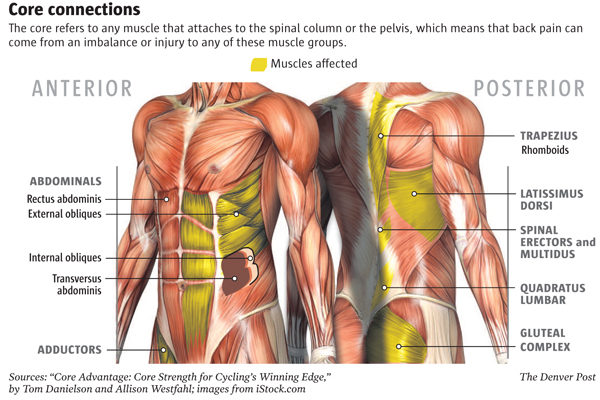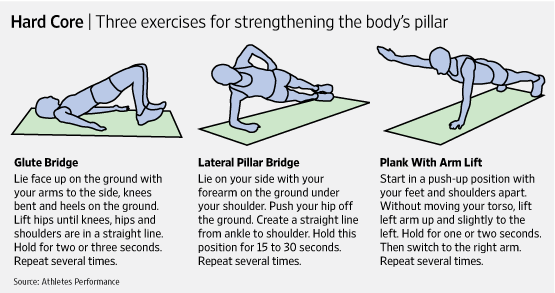As you may have seen from a previous post, I was asked by AXA PPP healthcare to take part in a live study, to explore the prevalence of poor posture and back pain in the UK. AXA PPP healthcare’s study included ten office workers and ten active workers, and the company also surveyed 2,000 workers in the UK. Fifty-five per cent of people said they were affected by back pain. Spending so much time in the gym, I regularly see examples of poor posture, and am finding the prevalence of back pain to be an increasing problem. This is often related to poor exercise technique, and weak or inactive core muscles.
Posture is one of the first things Hall Training Systems addresses in new clients, as we have seen the problems that can occur if it’s not tackled. These include limited joint mobility, increased muscle tightness, poor range of motion and limited power output, which will all have a detrimental impact on an individuals’ training and performance. This is of course alongside the more serious problems, both physical and mental. AXA PPP healthcare’s survey found that 60 percent of participants’ sleep is affected; while a quarter experience a negative impact on their work, and 19 per cent on their sex life and family life – Ah! Now I have your attention!
The majority of the muscles that control posture are collectively known as the core, and are found predominantly in the torso:

Upper torso
The trapezius muscle attaches the shoulder blades to the spine, covering the neck, shoulder and mid back. For good posture this muscle needs to be equally strong across the back as the front of the body. The rhomboid muscles are responsible for retracting the shoulder blades, helping to bring the shoulders back and together. I frequently see people in whom the rhomboids are overextended and weak across the back of the body, as a result of being too tight at the front, causing the shoulder blades to pop forward and resulting in a slumped posture.
Middle torso
The abdominals are also crucial in maintaining posture but probably the one that is forgotten is the transverse abdominis (TVA). This muscle lies deep below the internal obliques and is thought to be vital for thoracic and pelvic stability. On the back of the body, the muscles that run parallel to the spine – the spinalis, longissimus and iliocostalis, otherwise known as the erector spinae – work simultaneously to extend the spine. The vertebrae are connected and supported by a small group of muscles deep in the body, that runs the length of the spine - the multifidus muscles.
Lower torso
The lower part of the body is again supported by again our friend, the transverse abdominis. The iliacus and the psoas muscles support the lumbar region of the back. Let’s not also forget the glutes and adductors, whose job it is to provide pelvic stability and support. Contrary to popular belief the glutes and adductor muscles are and should be treated as part of the core.
This list is by no means exhaustive. Different people will have diverse weaknesses and need to focus on different exercises in order to correct them. But posture is something everyone should be aware of. Last week I got the results back from the live study and I was surprised to find that I spend 50% of my working day in bad posture. Most of this time is when I get back from work late, and spend a few hours at the computer writing programmes, nutrition plans, and social media posts. I spend most of my day on my feet, so I was quite surprised at the result, and asked to know about the results from the office workers. That group spent 66% of the trial in bad posture!
It is crucial that all people, but especially office workers, pay attention to their postural muscles and actively engage them. Unfortunately, it takes time to build good posture. It’s something that needs to be worked on every day, both in and out of the gym. The research by AXA PPP healthcare showed that 2pm is the time office workers are most likely to slouch, and that Mondays are the worst day of the week for poor posture. Getting up for a five minute walk every hour can help draw your attention to the problem, and give you chance to reset your position when you sit down again.
It is possible to tackle back pain and poor posture. It’s important to keep moving. A third of respondents to the survey thought it was best to rest and it’s definitely not! Try to maintain your normal routine, but avoid any activity that will put unnecessary pressure on your back. Always seek expert advice when pain occurs. It may be that there are a few simple exercises you can do to ease the problem. Two thirds of respondents to the survey said they knew what good posture was, but admitted they don’t usually apply it. It’s so easy to fall into this group, as the study I did revealed, but with some awareness and hard work the problem can be resolved.
So, when you next find yourself presented with the onset of back pain, I would advise you take 10 minutes, to get up, walk about and even possibly work on that core of yours. At the end of the day, it’s pointless boasting how hardcore your workout was down at the gym when you lack the real definition of hard-core!
Visit AXA PPP healthcare’s online resource Muscles, Bones & Joints for more tips, advice and information on good posture and dealing with back pain.
Join the conversation on Twitter: @axappphealth @Hall_Training
About Chris Hall
As the founder of Hall Training Systems, it is my mission to provide you with the very best personal training experience. I set up Hall Training Systems as Oxford's leading personal training service in nutrition, performance and weight loss, ensuring I can deliver the very best in training techniques.
You can find me on Facebook, Google+ or why not even give us a Tweet @Hall_Training


